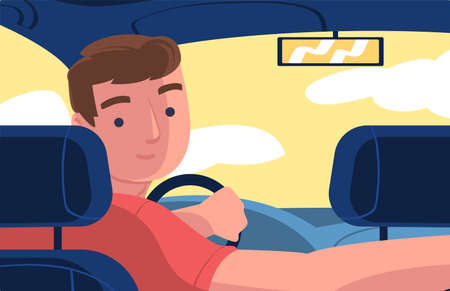1. Stay Alert and Avoid Distractions
One of the most important defensive driving techniques is staying alert and avoiding distractions. When youre behind the wheel, your full attention should be on the road. Even a momentary lapse in focus can lead to dangerous situations.
Keep Your Eyes on the Road
Always keep your eyes on the road and be aware of your surroundings. Check your mirrors frequently to monitor nearby vehicles, pedestrians, and potential hazards. This helps you anticipate and react quickly to any unexpected events.
Avoid Using Mobile Devices
Using your phone while driving is extremely dangerous. Texting, calling, or even checking notifications can take your eyes off the road for several seconds, increasing the risk of accidents. If you need to use your phone, pull over safely before doing so.
Stay Focused on Driving
Distractions come in many forms, not just cell phones. Eating, adjusting the radio, talking to passengers, or even daydreaming can interfere with your ability to drive safely. Stay mentally engaged and keep both hands on the steering wheel to maintain control.
Common Driving Distractions and How to Avoid Them
| Distraction | How to Avoid It |
|---|---|
| Texting | Put your phone on silent or use driving mode. |
| Eating | Finish meals before getting behind the wheel. |
| Talking to passengers | Keep conversations light and non-distracting. |
| Adjusting music | Set up your playlist before driving. |
By staying alert and minimizing distractions, you increase your ability to react quickly to potential hazards, making the road safer for yourself and others.
2. Maintain a Safe Following Distance
Keeping a safe distance from the vehicle in front of you is one of the most important defensive driving techniques. This gives you enough reaction time in case of sudden stops or emergencies, reducing the risk of collisions.
Why Safe Following Distance Matters
Maintaining proper spacing between your car and others on the road helps prevent rear-end accidents, ensures smoother traffic flow, and gives you time to react if something unexpected happens.
The Three-Second Rule
A simple way to measure a safe following distance is the three-second rule:
- Pick a stationary object on the side of the road (like a signpost or tree).
- When the car in front of you passes that object, start counting: “one thousand one, one thousand two, one thousand three.”
- If you pass the object before reaching three seconds, you’re too close and should back off.
Adjusting for Different Conditions
Sometimes, three seconds isnt enough. Increase following distance in these situations:
| Condition | Recommended Following Distance |
|---|---|
| Normal Conditions | 3 Seconds |
| Rain or Wet Roads | 4 Seconds |
| Night Driving | 4-5 Seconds |
| Snow or Ice | 6+ Seconds |
| Heavy Traffic | More Space If Possible |
Tips for Keeping a Safe Distance
- Stay alert and watch the behavior of the car ahead.
- Avoid tailgating – no matter how slow the driver in front is going.
- Increase distance when following larger vehicles (they block your view).
- Check your mirrors frequently to ensure vehicles behind aren’t too close.
What to Do If Someone Is Tailgating You
If a driver is following you too closely, avoid braking suddenly. Instead, gradually slow down and, if necessary, change lanes to let them pass.

3. Be Aware of Your Surroundings
Being aware of your surroundings is one of the key techniques in defensive driving. You should always be scanning the road, checking your mirrors, and anticipating possible dangers. This helps you react quickly and stay safe while driving.
Continuously Scan Your Surroundings
Instead of just focusing on the car in front of you, make it a habit to scan the entire road. Look ahead to see potential obstacles, such as traffic slowdowns, road debris, or sudden stops. Check both sides of the road for pedestrians and cyclists, and be alert for changing traffic signals or unexpected movements from other vehicles.
Check Your Mirrors Frequently
Your mirrors are crucial for maintaining awareness of what’s happening around you. Check your rearview and side mirrors every few seconds to monitor nearby vehicles and spot any fast-approaching cars. This is especially important when merging, changing lanes, or stopping suddenly.
How Often to Check Your Mirrors
| Driving Situation | How Often to Check Mirrors |
|---|---|
| Normal Driving | Every 5-8 seconds |
| Before Changing Lanes | Before and during the maneuver |
| In Heavy Traffic | Every few seconds |
| When Stopping | Before and while slowing down |
Anticipate Potential Hazards
Defensive driving requires anticipating risks before they become a problem. Watch for pedestrians who may suddenly cross the road, cyclists merging into traffic, and other drivers who might swerve unexpectedly. Keeping a safe following distance and avoiding blind spots can also help prevent accidents.
Common Hazards to Watch For
- Sudden lane changes by other drivers
- Pedestrians stepping off curbs without looking
- Motorcyclists and cyclists weaving through traffic
- Cars stopping unexpectedly in front of you
- Debris or potholes on the road
By staying constantly aware of your surroundings, you can spot dangers early and take necessary precautions to stay safe on the road.
4. Four. Adjust for Weather and Road Conditions
Driving in different weather conditions requires adjusting your speed and techniques to stay safe on the road. Rain, snow, fog, and poorly maintained roads can all impact visibility and traction, increasing the risk of accidents. Knowing how to modify your driving for each situation is essential.
Lower Your Speed
Speed limits are set for ideal conditions, but when the weather changes, so should your speed. Wet, icy, or foggy roads make it harder to stop quickly, so reducing your speed will give you more time to react to potential hazards.
Increase Following Distance
In poor conditions, your cars stopping distance increases. Normally, you should keep at least a three-second following distance behind the car in front of you. However, in bad weather, you should extend this to at least six seconds to allow extra time to stop safely.
Use Headlights Properly
Turn on your headlights in low visibility conditions like rain, fog, or snow. This makes you more visible to other drivers, even during daylight hours. However, avoid using high beams in fog, as they can reflect off the fog and reduce visibility.
Avoid Sudden Movements
Quick acceleration, hard braking, and sharp turns can cause your vehicle to lose control in slippery conditions. Make smooth, gradual movements to maintain traction and avoid skidding.
Know How to Handle Skidding
If your car starts to skid, stay calm and follow these steps:
- Take your foot off the accelerator.
- Steer in the direction you want to go.
- Avoid slamming on the brakes, as this can make the skid worse.
Weather Condition Adjustments
Here’s a quick guide on how to adjust your driving for different weather conditions:
| Weather Condition | Driving Adjustment |
|---|---|
| Rain | Reduce speed, turn on headlights, avoid standing water. |
| Snow/Ice | Slow down, increase following distance, avoid sudden movements. |
| Fog | Use low beams, reduce speed, avoid passing other cars. |
| Poorly Maintained Roads | Watch for potholes, keep a firm grip on the wheel, drive cautiously. |
Stay Aware and Prepared
Always check the weather and road conditions before you drive. If conditions are severe, consider delaying your trip or taking an alternate route. Being proactive and adapting your driving style can help keep you and others safe on the road.
5. Five. Have an Escape Plan
Always Stay Prepared for the Unexpected
One of the key principles of defensive driving is always having an escape plan. No matter how careful you are, there will always be unpredictable factors on the road. Identifying potential escape routes can help you avoid collisions and stay safe in emergency situations.
How to Identify Escape Routes
Being aware of your surroundings and anticipating possible dangers is essential. Here are some ways to ensure you always have an escape plan:
| Situation | Escape Strategy |
|---|---|
| Heavy traffic with cars close behind | Leave space ahead to allow room for sudden stops |
| Highway driving with fast-moving traffic | Stay in a lane that offers an open shoulder or exit |
| City driving with pedestrians and cyclists around | Keep an eye on sidewalks and crosswalks to anticipate movements |
| Approaching an intersection | Cover your brakes and scan side streets for potential hazards |
Stay Mentally Prepared
Having an escape plan isn’t just about knowing where to go—it’s also about being mentally ready to react. Stay focused, avoid distractions, and always be scanning your surroundings. If a dangerous situation arises, you’ll be able to make a quick and safe decision.


